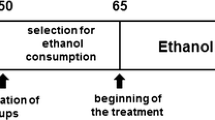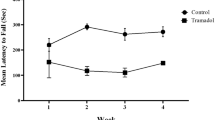Summary
Methylazoxymethanol (MAM), a powerful antimitotic, has been extensively used to affect rodent CNS development. Here we show that MAM causes different effects on mouse cerebellum depending on the age of the injected pup. Sublethal doses were determined for each age. A single injection at birth permanently reduces the number of cells. In addition, the cytoarchitecture was greatly perturbed: Purkinje cells retained an immature aspect and were dispersed through the cerebellar cortex. A single dose of MAM injected into 5 day old mice also affected the number of cells but, at the level of light microscopy, the cytoarchitecture of the cerebellar cortex appeared not to be altered. Purkinje cells, however, showed some immaturity and degenerated around the 22nd postnatal day. This modulation of MAM effect appears to provide a good model for studying cerebellar ontogeny and neuronal plasticity.
Similar content being viewed by others
References
Berry M, Bradley P, Borges S (1978) Environmental and genetic determinants of connectivity in the central nervous system — an approach through dendritic field analysis. In: Corner MA (ed) Progress in brain research, Vol 48. Elsevier, Amsterdam, pp 133–146
Burton K (1956) A study of conditions and mechanism of the diphenylamine reaction of the colorimetric estimation of desoxyribonucleic acid. Biochem J 62: 315
Chanda R, Woodward DO, Griffin S (1973) Cerebellar development in the rat after early postnatal damage by methylazoxymethanol DNA, RNA and protein during recovery. J Neurochem 21: 547–555
Chen S, Hillman DE (1982) Plasticity of the parallel fibre-Purkinje cell synapse by spine take-over and new synapse formation in the adult rat. Brain Res 240: 205–220
Clos J, Legrand C, Legrand J (1980) Effects of thyroid state on the formation and early morphological development of Bergmann glia in the developing rat cerebellum. Dev Neurosci 3: 199–208
Das G (1976) Differentiation of Bergmann glia cells in the cerebellum: A Golgi study. Brain Res 110: 199–213
Ghandour MS, Derer P, Labourdette G, Delaunoy J-P, Langley OK (1984) Glial cell markers in the reeler mutant mouse: A biochemical and immunochemical study. J Neurochem 36: 195–200
Hájos F, Patel AJ, Balázs R (1973) Effect of thyroid deficiency on the synaptic organization of the rat cerebellar cortex. Brain Res 50: 387–401
Jones M, Yang M, Mickelsen O (1972) Effects of methylazoxymethanol glucoside and methylazoxymethanol acetate on the cerebellum of the postnatal swiss albino mouse. Fed Proc 31: 1508–1511
Lovell KL, Jones MZ (1980) Partial external germinal layer regeneration in the cerebellum following methylazoxymethanol administration: Effects on Purkinje cell dendritic spines. J Neuropathol Exp Neurol 39: 541–548
Lovell KL, Goetting MG, Jones MZ (1980) Regeneration in the cerebellum following methylazoxymethanol-induced destruction of the external germinal layer. Dev Neurosci 3: 128–139
Lowry OM, Rosebrough NJ, Farr L, Randall RJ (1951) Protein measurement with the folin phenol reagent. J Biol Chem 193: 265–275
Matsumoto H, Spatz M, Laqueur GL (1972) Quantitative changes with age in the DNA content of methylazoxymethanol-induced microencephalic rat brain. J Neurochem 19: 297–306
Rakic P (1971) Neuron-glia relationship during granule cell migration in developing cerebellar cortex — a Golgi and electron microscopic study in Macacus rhesus. J Comp Neurol 141: 283–312
Schmidt G, Thannhauser SJ (1945) A method for the determination of desoxyribonucleic acid and phosphoproteins in animal tissues. J Biol Chem 161: 83–96
Slevin JT, Johnston MV, Bizière K, Coyle JT (1982) Methylazoxymethanol acetate ablation of mouse cerebellar granule cells: Effects on synaptic neurochemistry. Dev Neurosci 5: 3–12
Yu WHA (1976) The effect of 5-bromodeoxyuridine on the postnatal development of the rat cerebellum — a biochemical study. Brain Res 118: 281–291
Yu WHA (1979) Restitution of bromodeoxyuridine-induced changes in cerebellar development. Neuropathol Appl Neurobiol 5: 41–48
Author information
Authors and Affiliations
Rights and permissions
About this article
Cite this article
Bejar, A., Roujansky, P., de Barry, J. et al. Different effect of methylazoxymethanol on mouse cerebellar development depending on the age of injection. Exp Brain Res 57, 279–285 (1985). https://doi.org/10.1007/BF00236533
Received:
Accepted:
Issue Date:
DOI: https://doi.org/10.1007/BF00236533




